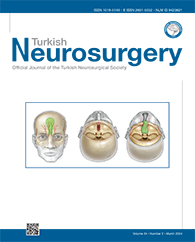2West Virginia University School of Medicine, Department of Neurosurgery, Morgantown, WV, USA
3The Permanente Medical Group, Department of Neurosurgery, Sacramento, CA, USA DOI : 10.5137/1019-5149.JTN.20662-17.1 The paramedian forehead flap (PMFF) has been well described for nasal reconstruction. However, it has never been reported for use in the repair of high flow anterior skull base cerebrospinal fluid (CSF) leaks.
The patient was a 55 year-old African American male cocaine abuser who initially presented with a high flow anterior skull base CSF leak, extensive pneumocephalus, and intra-cerebral and intra-ventricular abscesses with an oro-nasal-cerebral fistula. The patent initially underwent bi-frontal craniotomy, exenteration of the frontal sinus, abdominal fat graft, resection of intra-cerebral abscesses, and repair of high flow anterior skull base CSF leak with a pedicled pericranial flap (PF). Eighteen months after the patient?s surgery, he had resumed his use of cocaine and suffered necrosis of his PF. This caused his high flow CSF leak to recur. After extensive psychiatric treatment, he stopped cocaine use and was subsequently repaired with a pedicled de-epithelialized PMFF originating off the bilateral supratrochlear arteries. The patient has had no CSF leak for 3 years, and primary closure of the forehead was achieved with good cosmetic outcome.
This case highlights the use of PMFF for the treatment of recurrent high flow anterior skull base CSF leak. It also highlights the importance of treatment of the patient?s underlying medical disorder, in this case, the patient?s addiction to cocaine. We provide a detailed discussion for the use of the de-epithelialized PMFF and how it can be utilized as a vascularized reconstructive technique to repair complex refractory CSF leaks.
Keywords : Cocaine abuse, High-flow cerebrospinal fluid leak, Paramedian forehead flap, Pedicled reconstruction technique




